
A detail of Donatello's cantoria in the Museo dell'Opera del Duomo of Florence. (Photo by Sailko)
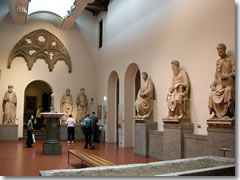
The Museo dell'Opera Del Duomo (Museum of Cathedral Works) is directly behind the cathedral at Piazza del Duomo 9—perhaps hiding back here is how this rich and informative museum remains largely undiscovered and devoid of crowds—though the expanded and more obvious entrance helps.
All the statues removed from the cathedral facade (including the original, 15th century facade), as well as from Giotto's bell tower and from the baptistery in order to preserve them out of the elements are kept here—including the original panels from Ghiberti's famous Gates of Paradise.
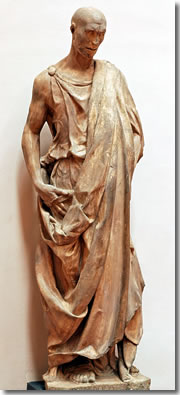
Lo Zuccone ("Pumpkinhead"), actually a statue of Habakuk by Donatello. (Photo by Jastrow)What all that means in practical terms is that the rooms are filled with early works by Andrea Pisano, Arnolfo di Cambio, Luca della Robbia, and especially the expressive and emotional statues of Donatello, including the drooping aged face of the Beardless Prophet; the sad fixed gaze of Jeremiah; and the misshapen ferocity of the leering bald prophet Habakuk that locals call Lo Zuccone ("Pumpkinhead").
Also here is one of Donatello's more morbidly fascinating sculptures, a late work in polychrome wood of The Magdalene (1453–55), emaciated and weeping and veritably dripping with penitence and looking creepily haggard.
Mounted on the walls above are two putti-encrusted marble cantorie (choir lofts, though they might have actually been organ lofts).
The slightly earlier one (1431) on the entrance wall is by Luca della Robbia. His panels are in perfect early Renaissance harmony, both within themselves and with each other, and they show della Robbia's mastery of creating great depth within a shallow piece of stone. Each panel is crowded with a little Renaissance boy band or girl group strumming lutes, banging drums, and belting out the hits. (The actual panels are collected down at eye level, with plaster replicas taking their place in the choir loft above.)
Across the room, Donatello's cantoria (1433–38) takes off in a new artistic direction as his singing cherubs literally break through the boundaries of the "panels" to leap and race around the entire cantoria behind the mosaicked columns, one panel spilling into the next to create a single long scene, the kiddies flitting in and around the columns and peeking out from behind them, pushing and shoving and laughing away.
Two very different styles, both delightful.
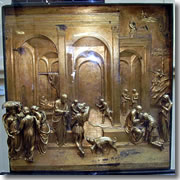
Esau and Jacob, a scene from Ghiberti's Gates of Paradise. (Photo by Sailko)The star exhibit is the collection of original gilded bronze relief panels from Ghiberti's Gates of Paradise from the baptistery. Ghiberti devoted 27 years to this project (1425–52), and you can now admire up close his masterpiece of schiacciato (squished) relief—using the Donatello technique of almost sketching in perspective to create the illusion of depth in low relief.
They were removed from the Baptistery to save them from the wear and tear of the weather (those now on the baptistery doors are replicas), and put on display here under glass after they were cleaned and restored.
(I remember them still back on the actual baptistery gates themselves in the mid 1980s, when the piazza surrounding them was, believe it or not, a parking lot. Each panel was caked in so much sooty black dirt—the legacy of car exhaust from before Italy had catalytic converters—you could barely tell what was on them. Just a few shiny parts poked out here and there, marking the bits where decades of tourists' curious fingers had rubbed away the grime.)
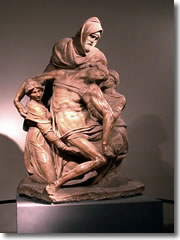
Michelangelo's Pietà at Florence's Museo dell'Opera del Duomo. (Photo by Marina Milella)On the landing between the first and second floors sits Michelangelo's Pietà group—the figure of Nicodemus at the back is said to be a self-portrait.
Then again, it is also said of this work that either:
Who knows? What is pretty certain—based on obvious stylistic differences—is that his followers probably did carve at least some of the figures—particularly the polished figure of Mary Magdalene on the left.
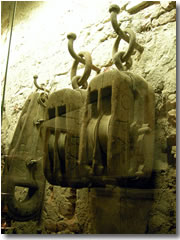
Pulleys designed by Brunelleschi for the construction o the dome on the cathedral, at the Museo dell'Opera del Duomo, Florence. (Photo by Sailko)There are also a series of intriguing exhibits related to the building of the cathedral, including some of the actual gear and block and tackle invented by Brunelleschi to engineer his revolutionary Cathedral dome in 1420–36 (along with a plaster cast of his death mask).
The full story is told on the page about Brunelleschi, but in brief, there were two problems to solve.
(Fun aside: Brunelleschi also installed a tavern up in the job site itself so his workers wouldn't waste time lowering themselves back down to the ground and then up again for lunch.)
To ferry workers, equipment, and supplies up to his novel working environment, Brunelleschi also adapted and invented new pulley systems, cranes, and those hanging scaffolds, some of which are the items on display here. Yes, these are the actual, 590-year-old wooden devices that revolutionized the world of architectural engineering in the early 15th century.
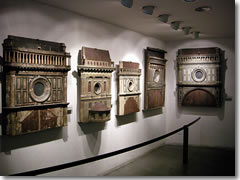
Facade submissions for the Duomo of Florence, in the Museo dell'Opera del Duomo. (Photo by Sailko)There are also several 16th century wooden models of potential cathedral facades offered by the architectural greats of the day, including Giambologna and Bernardo Buontalenti.
These were part of a 1588 competition finally to give the Duomo a proper High Renaissance facade. As part of the buildup to the competition, in 1587 church authorities merrily scraped away the original, partial facade by Arnolfo di Cambio that had graced the bottom third of the cathedral front since 1420.
(Luckily, they saved di Cambio's original statues, now on display in the first room as pictured in the photograph up at the start of this page.)
Unfortunately, they jumped the gun with the whole "destroying the existing facade" move. The patron behind the work—Grand Duke Francesco de' Medici—died before he could choose from among the submissions. For various reasons, none of the new plans were every selected or built.
Subsequent attempts to get a facade program off the ground failed as well, and the Duomo remained largely faceless for more than 300 years.
The Duomo remained faceless until the local purses of the 18th century—heavy with money and relentless bad taste—hired Emilio De Fabris to design the cathedral's current, Neo-Gothic facade in 1871. As this was in the wake of nationalist euphoria when Florence was (briefly) capital of the newly created Kingdom of Italy, he did the whole thing in the colors of the country's new flag: Red, white and green.
Piazza del Duomo 9/Piazza San Giovanni
tel. +39-055-230-2885
www.operaduomo.firenze.it
Daily 9am–7pm
Closed the first Tues of every month
€15 (covers entire Duomo Group)
With Firenze Card: Free
Bus: C2; 14, 23, C1
Hop-on/hop-off: Teatro Verdi (A); Stazione FS SMN (A, B), Piazza Stazione (C)
Planning your day: The Duomo museum will eat up 45–90 minutes of your time, depending on how into it you get.
Of the adjacent and related sights in the Duomo group: It should take about 20–30 minutes inside the Duomo itself, another 20–30 minutes in and around the Baptistery. Climbing either Brunelleschi's dome (463 steps) or Giotto's bell tower (414 steps) will take about an hour each..
Except Sundays, the baptistery's only open in the afternoons (well, after 11:15am), so on a tight schedule visit all the Duomo buildings later in the day so you can get them all in at once. The cathedral itself closes first, so don't save it for last. (On Sundays, however, arrive just after early lunch to hit the baptistery first—as it's open only 8:30am to 2pm—then do the cathedral once it reopens after morning mass.)
Last entry 40 minutes prior to closing.
Take a guided tour of the Museo dell'Opera del Duomo with one of our partners:
The expanded museum has a pretty nifty gift shop.
Share this page
Search ReidsItaly.com
Piazza del Duomo 9/Piazza San Giovanni
tel. +39-055-230-2885
www.operaduomo.firenze.it
Daily 9am–7pm
Closed the first Tues of every month
€15 (covers entire Duomo Group)
With Firenze Card: Free
Bus: C2; 14, 23, C1
Hop-on/hop-off: Teatro Verdi (A); Stazione FS SMN (A, B), Piazza Stazione (C)